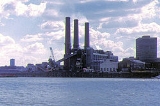
Woolwich Power Station
Encyclopedia
Woolwich Power Station was a coal-fired power station on the south bank of the Thames at Woolwich
.
The first station was opened at the site in 1893 by the Woolwich District Electric Lighting Company adapted from boat repair shops, and subsequently taken over by the Metropolitan Borough of Woolwich
. During later construction work in 1912 the timbers of a Tudor warship believed to be Henry VII's 1488 ship Sovereign were uncovered on the site.
The station was redeveloped in the 1920s and again in the 1940s and 1950s, ultimately having three huge brick chimneys. It occupied a site of just over seven and a half acres.
The coal used by the station was usually shipped from the Yorkshire and Northumberland areas and offloaded by crane onto a deep trough conveyor. At its peak the station was burning over 1000 tons of coal a day.
The station closed on 30 October 1978 with a generating capacity of 57 megawatts. One chimney was demolished by hand in 1978, and the remaining two by explosives in 1979. The site of the main power station building is now occupied by the Waterfront Leisure Centre car park; part of the coaling jetty remains.
Woolwich
Woolwich is a district in south London, England, located in the London Borough of Greenwich. The area is identified in the London Plan as one of 35 major centres in Greater London.Woolwich formed part of Kent until 1889 when the County of London was created...
.
The first station was opened at the site in 1893 by the Woolwich District Electric Lighting Company adapted from boat repair shops, and subsequently taken over by the Metropolitan Borough of Woolwich
Metropolitan Borough of Woolwich
The Metropolitan Borough of Woolwich was a Metropolitan borough in the County of London from 1900 to 1965.-Formation:The borough was formed from the civil parishes :*Eltham *Plumstead...
. During later construction work in 1912 the timbers of a Tudor warship believed to be Henry VII's 1488 ship Sovereign were uncovered on the site.
The station was redeveloped in the 1920s and again in the 1940s and 1950s, ultimately having three huge brick chimneys. It occupied a site of just over seven and a half acres.
The coal used by the station was usually shipped from the Yorkshire and Northumberland areas and offloaded by crane onto a deep trough conveyor. At its peak the station was burning over 1000 tons of coal a day.
The station closed on 30 October 1978 with a generating capacity of 57 megawatts. One chimney was demolished by hand in 1978, and the remaining two by explosives in 1979. The site of the main power station building is now occupied by the Waterfront Leisure Centre car park; part of the coaling jetty remains.

